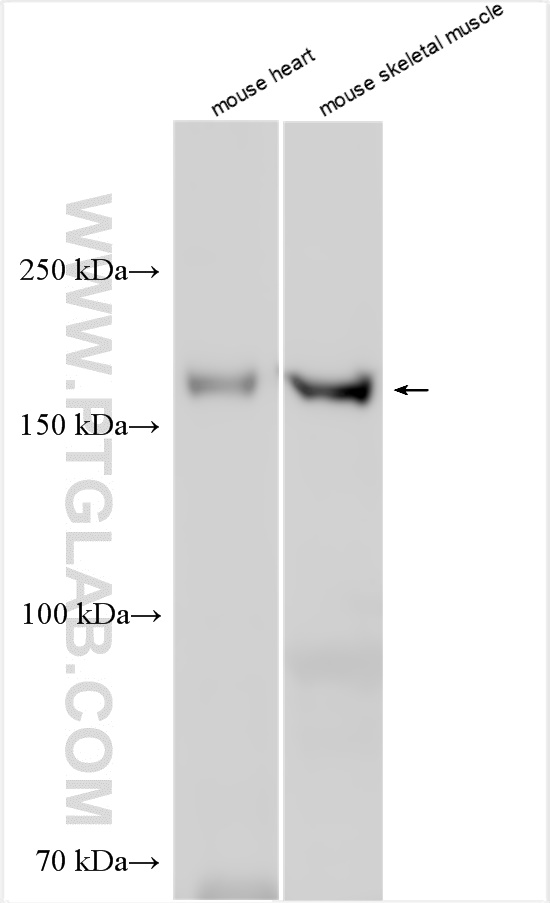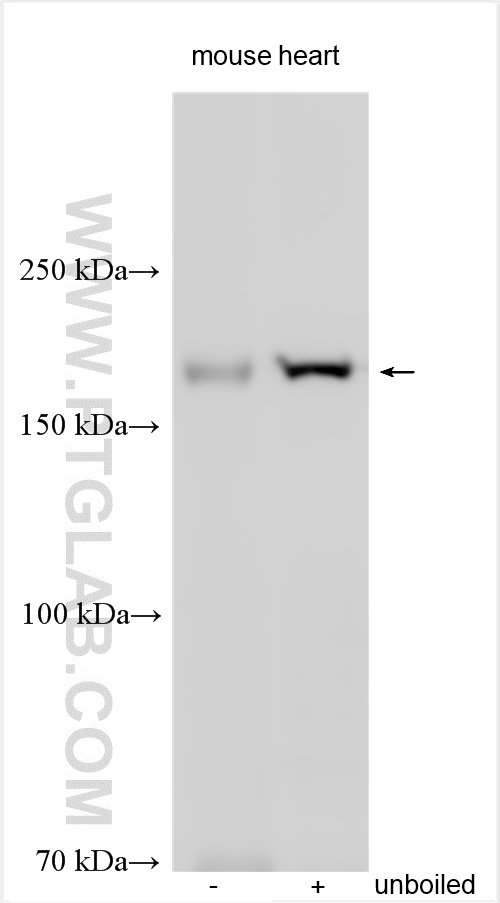验证数据展示
经过测试的应用
| Positive WB detected in | mouse heart tissue, mouse skeletal muscle tissue, unboiled mouse heart tissue |
推荐稀释比
| 应用 | 推荐稀释比 |
|---|---|
| Western Blot (WB) | WB : 1:500-1:1000 |
| It is recommended that this reagent should be titrated in each testing system to obtain optimal results. | |
| Sample-dependent, Check data in validation data gallery. | |
产品信息
13599-1-AP targets SUR2/ABCC9 in WB, ELISA applications and shows reactivity with human, mouse samples.
| 经测试应用 | WB, ELISA Application Description |
| 经测试反应性 | human, mouse |
| 免疫原 | SUR2/ABCC9 fusion protein Ag4536 种属同源性预测 |
| 宿主/亚型 | Rabbit / IgG |
| 抗体类别 | Polyclonal |
| 产品类型 | Antibody |
| 全称 | ATP-binding cassette, sub-family C (CFTR/MRP), member 9 |
| 别名 | ABC37, ABCC9, CMD1O, Sulfonylurea receptor 2, SUR2, SUR2/ABCC9 |
| 计算分子量 | 1549 aa, 174 kDa |
| 观测分子量 | 174 kDa |
| GenBank蛋白编号 | BC033804 |
| 基因名称 | SUR2/ABCC9 |
| Gene ID (NCBI) | 10060 |
| RRID | AB_3085419 |
| 偶联类型 | Unconjugated |
| 形式 | Liquid |
| 纯化方式 | Antigen affinity purification |
| UNIPROT ID | O60706 |
| 储存缓冲液 | PBS with 0.02% sodium azide and 50% glycerol , pH 7.3 |
| 储存条件 | Store at -20°C. Stable for one year after shipment. Aliquoting is unnecessary for -20oC storage. |
背景介绍
ABCC9, also known as SUR2, belongs to the ABC transporter superfamily. ABCC9 is a subunit of ATP-sensitive potassium channels (KATP), forming cardiac and smooth muscle-type KATP channels with KCNJ11. KCNJ11 forms the channel pore while ABCC9 is required for activation and regulation (PMID: 9831708). ABCC9 is thought to form ATP-sensitive potassium channels in cardiac, skeletal, vascular, and non-vascular smooth muscle. Defects in ABCC9 cause dilated cardiomyopathy 10 and familial atrial fibrillation type 12 (ATFB12)(PMID: 15034580,17245405).
实验方案
| Product Specific Protocols | |
|---|---|
| WB protocol for SUR2/ABCC9 antibody 13599-1-AP | Download protocol |
| Standard Protocols | |
|---|---|
| Click here to view our Standard Protocols |

